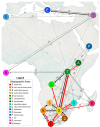Repeatedly Northwards and Upwards: Southern African Grasslands Fuel the Colonization of the African Sky Islands in Helichrysum (Compositae)
- PMID: 37299192
- PMCID: PMC10255704
- DOI: 10.3390/plants12112213
Repeatedly Northwards and Upwards: Southern African Grasslands Fuel the Colonization of the African Sky Islands in Helichrysum (Compositae)
Abstract
The Afromontane and Afroalpine areas constitute some of the main biodiversity hotspots of Africa. They are particularly rich in plant endemics, but the biogeographic origins and evolutionary processes leading to this outstanding diversity are poorly understood. We performed phylogenomic and biogeographic analyses of one of the most species-rich plant genera in these mountains, Helichrysum (Compositae-Gnaphalieae). Most previous studies have focused on Afroalpine elements of Eurasian origin, and the southern African origin of Helichrysum provides an interesting counterexample. We obtained a comprehensive nuclear dataset from 304 species (≈50% of the genus) using target-enrichment with the Compositae1061 probe set. Summary-coalescent and concatenation approaches combined with paralog recovery yielded congruent, well-resolved phylogenies. Ancestral range estimations revealed that Helichrysum originated in arid southern Africa, whereas the southern African grasslands were the source of most lineages that dispersed within and outside Africa. Colonization of the tropical Afromontane and Afroalpine areas occurred repeatedly throughout the Miocene-Pliocene. This timing coincides with mountain uplift and the onset of glacial cycles, which together may have facilitated both speciation and intermountain gene flow, contributing to the evolution of the Afroalpine flora.
Keywords: Afroalpine; Afromontane; Asteraceae; Helichrysum; biogeography; evolution; long-distance dispersal; phylogeny; target-enrichment.
Conflict of interest statement
The authors declare no conflict of interest.
Figures




Similar articles
-
Biome conservatism prevailed in repeated long-distance colonization of Madagascar's mountains by Helichrysum (Compositae, Gnaphalieae).Mol Phylogenet Evol. 2025 Mar;204:108283. doi: 10.1016/j.ympev.2024.108283. Epub 2025 Jan 4. Mol Phylogenet Evol. 2025. PMID: 39761774
-
Frequent colonization and little in situ speciation in Senecio in the tropical alpine-like islands of eastern Africa.Am J Bot. 2016 Aug;103(8):1483-98. doi: 10.3732/ajb.1600210. Epub 2016 Aug 23. Am J Bot. 2016. PMID: 27555436
-
The enigmatic tropical alpine flora on the African sky islands is young, disturbed, and unsaturated.Proc Natl Acad Sci U S A. 2022 May 31;119(22):e2112737119. doi: 10.1073/pnas.2112737119. Epub 2022 May 26. Proc Natl Acad Sci U S A. 2022. PMID: 35617436 Free PMC article.
-
Climatic oscillations, dispersibility and adaptability behind worldwide mountain radiations of the Helichrysum- Anaphalis-Pseudognaphalium (HAP) clade (Compositae).Ann Bot. 2025 May 31:mcaf110. doi: 10.1093/aob/mcaf110. Online ahead of print. Ann Bot. 2025. PMID: 40447279
-
African Mountain Thistles: Three New Genera in the Carduus-Cirsium Group.Plants (Basel). 2023 Aug 28;12(17):3083. doi: 10.3390/plants12173083. Plants (Basel). 2023. PMID: 37687332 Free PMC article.
Cited by
-
Non-radiative origin for alpine endemics of Draba (Brassicaceae) in the central mountains of the Japanese Archipelago.J Plant Res. 2025 Jul;138(4):563-573. doi: 10.1007/s10265-025-01643-7. Epub 2025 Apr 29. J Plant Res. 2025. PMID: 40299227 Free PMC article.
References
-
- Heald W.F. Sky Island. Van Nostrand; Princeton, NJ, USA: 1967.
-
- White F. The Afromontane region. In: Wegner M.J.A., editor. Biogeography and Ecology of Southern Africa. Volume 31. Springer; Dordrecht, The Netherlands: 1978. pp. 463–513. - DOI
-
- White F. Vegetation of Africa: A Descriptive Memoir to Accompany the UNESCO/AETFAT/UNSO Vegetation Map of Africa. UNESCO; Paris, France: 1983.
-
- Gehrke B., Linder H.P. Species richness, endemism and species composition in the tropical Afroalpine flora. Alp. Bot. 2014;124:165–177. doi: 10.1007/s00035-014-0132-0. - DOI
-
- Hedberg O. Evolution and speciation in a tropical high mountain flora. Biol. J. Linn. Soc. 1969;1:135–148. doi: 10.1111/j.1095-8312.1969.tb01816.x. - DOI
Grants and funding
LinkOut - more resources
Full Text Sources

